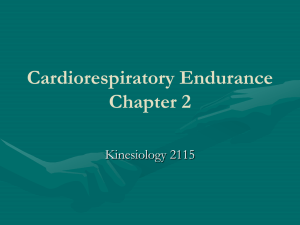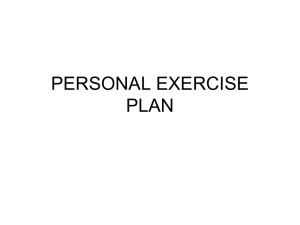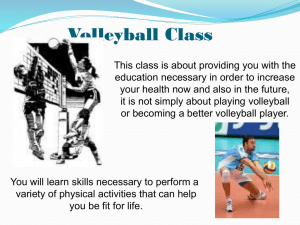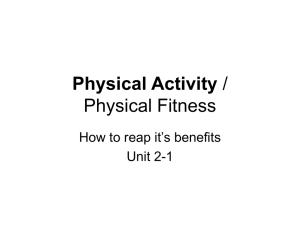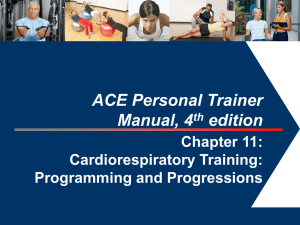ACE IFT model PPT
advertisement
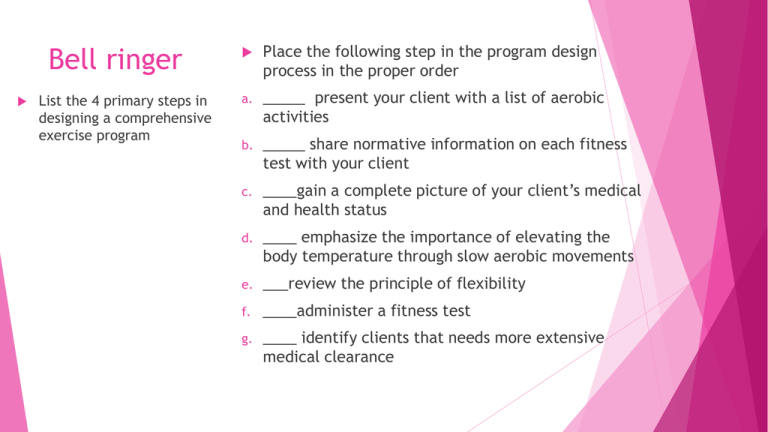
Bell ringer List the 4 primary steps in designing a comprehensive exercise program Place the following step in the program design process in the proper order a. _____ present your client with a list of aerobic activities b. _____ share normative information on each fitness test with your client c. ____gain a complete picture of your client’s medical and health status d. ____ emphasize the importance of elevating the body temperature through slow aerobic movements e. ___review the principle of flexibility f. ____administer a fitness test g. ____ identify clients that needs more extensive medical clearance Bell ringer List the 4 primary steps in designing a comprehensive exercise program Medical screening Physical fitness testing Exercise mode Design program Place the following step in the program design process in the proper order a. ___5__ present your client with a list of aerobic activities b. ___4__ share normative information on each fitness test with your client c. __1__gain a complete picture of your client’s medical and health status d. ___6_ emphasize the importance of elevating the body temperature through slow aerobic movements e. __7_review the principle of flexibility f. __3__administer a fitness test g. __2__ identify clients that needs more extensive medical clearance ACE Integrated Fitness Training Model IFT model Foundation of ACE IFT model is RAPPORT It develops trust and fosters client’s participation The greatest impact a personal training can have on a client’s life is to help that person change his or her habits and establish a positive relationship with exercise IFT Model: Client / Trainer relationship The first time a client and trainer meet, it is important for the trainer to encourage the client and create an environment where he or she can feel successful. Initial assessments can be detrimental to early program success Trainer needs to modify behavior and establish good attitude about exercise Many adults who are inactive now may have been inactive their whole lives To be a successful personal trainer you will need to apply 2 strategies: Fitness related behavior change and exercise adherence Implement comprehensive exercise programs to help client achieve their goals Make exercise fun, they need to make it through the first 2 -4 weeks Concentrating on fun and exercise adherence first then switch to weight loss or other goals. Match the traits of a good exercise consultant on the left with the descriptions on the right a. Sharing a story of your own failure to lose weight b. The opposite of “do as I say, not as I do” Genuineness c. Seeing things through your client’s eyes 5. Concreteness d. Showing concern and being available 6. Self disclosure e. Conveying a secureness in your self 7. Potency and self actualization f. Appreciating the worth of your client g. Solidifying essential ideas and elements 1. Empathy 2. Respect 3. Warmth 4. Match the traits of a good exercise consultant on the left with the descriptions on the right a. Sharing a story of your own failure to lose weight b. The opposite of “do as I say, not as I do” Genuineness (B) c. Seeing things through your client’s eyes 5. Concreteness (G) d. Showing concern and being available 6. Self disclosure (A) e. Conveying a secureness in your self 7. Potency and self actualization (E) f. Appreciating the worth of your client g. Solidifying essential ideas and elements 1. Empathy ( C ) 2. Respect (F) 3. Warmth (D) 4. ACE IFT model Includes functional and physiological assessments A comprehensive system for exercise programming that pulls together the complicated training parameters Organizes exercise science research into logical systems Has 2 principal training components: Functional movement and resistance training Cardiorespiratory training Both are broken down into 4 phases that provide trainers with strategies to determine and implement the most appropriate assessments and programs Phase 1: focus is improving health by correcting imbalances to improve joint stability and mobility, improve aerobic base Phase 2: progress clients toward improved fitness, aerobic intervals Phase 3: moving into performance area of health – fitness – performance continuum Phase 4: focused on improving performance through training for power, speed, agility, reactivity and anaerobic power. 2 Training Programs Functional movement and Resistance Training Cardiorespiratory Training To effectively utilize the ACE IFT model trainers must understand how to: Develop and enhance rapport Assess which stage a client is in for each training component Design exercise programs in each component Integrate component to provide clients with comprehensive training solutions Functional movement and Resistance Training: Phase 1 Stability and mobility training The principal goal of phase 1 is to develop postural stability without compromising mobility. The training focus is on the introduction of low-intensity exercise programs to improve the client’s posture. Exercise selection focuses on core and balance exercises. Neutral position, hold COG (center of gravity) No assessments of muscular strength or endurance are required prior to designing and implementing an exercise program during this phase. Assessments that should be conducted early in this phase include basic assessments of: Posture Balance Movement Range of motion of the ankle, hip, shoulder complex, and thoracic and lumbar spine Phase 2: Movement Training The primary focus during phase 2 is training movement patterns. Movement training focuses on the five primary movements of exercise: Bend-and-lift movements (e.g., squatting) Single-leg movements (e.g., lunging) Pushing movements Pulling movements Rotational (spiral) movements: in transverse plane Exercise programs emphasize the proper sequencing of movements and control of the body’s center of gravity. Whole-body movement patterns that utilize gravity as resistance are emphasized. Full ROM patterns with eccentric muscle action The general timeframe for movement training is two to eight weeks. Movement training: with a neighbor brainstorm real life examples of the primary movement exercises Bend and lift Single leg movements Pushing movements Forward Overhead Lateral downward Pulling movements Rotational movements Phase 3: Load Training In phase 3, the exercise program is advanced with the addition of an external force. (dumbbells, kettlebells, medicine balls, elastic tubing, tires) Knowledge of exercise science related to resistance training is applied. Exercise selection: start with single joint isometric and work towards total body movements Assessments of muscular strength and endurance are introduced. Many clients will stay in this phase for many years. Let their goals dictate how you advance Before progressing to phase 4, clients should develop the prerequisite strength necessary to move into training for: Power Speed Agility Quickness Phase 4: Performance Training Phase 4 emphasizes specific training to improve speed, agility, quickness, reactivity, and power. Maintain good posture and mobility Power training enhances the velocity of force production (ability of large muscles to produce a lot of force in a short time) Many clients will not progress to this stage of training. Assessments for measuring power, speed, agility, and quickness can be performed. Power training can also be effective at helping clients improve body composition. Exercise selection: plyometric jump training, medicine ball throws, kettlebell… Goal: increase rate coding: speed at which the motor units stimulate muscle to contract and produce force. Minimize transition time between eccentric and concentric phase of muscle action Cardiorespiratory Training Phase 1: Aerobic-base Training Phase 1 is focused on developing an initial aerobic base in clients who have been sedentary or near-sedentary. The intent is to build improvements in: Health Endurance Energy Mood Caloric expenditure Exercise should be performed at steady-state intensities in the low-to-moderate intensity range. No assessments are recommended during the aerobic-base phase. Monitor intensity using Talk test, should be below or at VT1 or RPE of 3 to 4. Phase 2: Aerobic-efficiency Training The second phase is dedicated to enhancing the client’s aerobic efficiency by: Progressing Increasing the frequency of sessions when possible Introducing the program through increased duration of sessions aerobic intervals The goal of introducing intervals is to improve: Aerobic The endurance by raising the intensity of exercise client’s ability to utilize fat as a fuel source Trainers can conduct the submaximal talk test to determine heart rate at the first ventilatory threshold (VT1). Some clients may perform cardiorespiratory exercise in this phase for many years if they have no goals of improving performance. Video explaining VT1 and VT2 http://www.acefitness.org/blog/1165/understanding-vt1-and-vt2 Phase 3: Anaerobic-endurance Training During phase 3, the primary focus is to improve performance. Assessment of the client’s cardiorespiratory capacity at the second ventilatory threshold (VT2) is appropriate. Higher-intensity intervals that develop anaerobic endurance are introduced. Balancing training time spent below VT1, between VT1 and VT2, and at or above VT2 should be considered. Zone 1 (< VT1): 70–80% of training time Zone 2 (VT1 to < VT2): <10% of training time Zone 3 (> VT2): 10–20% of training time The personal trainer should watch for signs of overtraining and scale back the program if symptoms occur. Phase 4: Anaerobic-power Training The primary focus is building on previous training, while also introducing new intervals for anaerobic power. These intervals are short-duration, high-intensity, and very taxing. Clients working in this phase: Are training for competition Have specific goals that relate to short-duration, high-intensity efforts during longer endurance events
